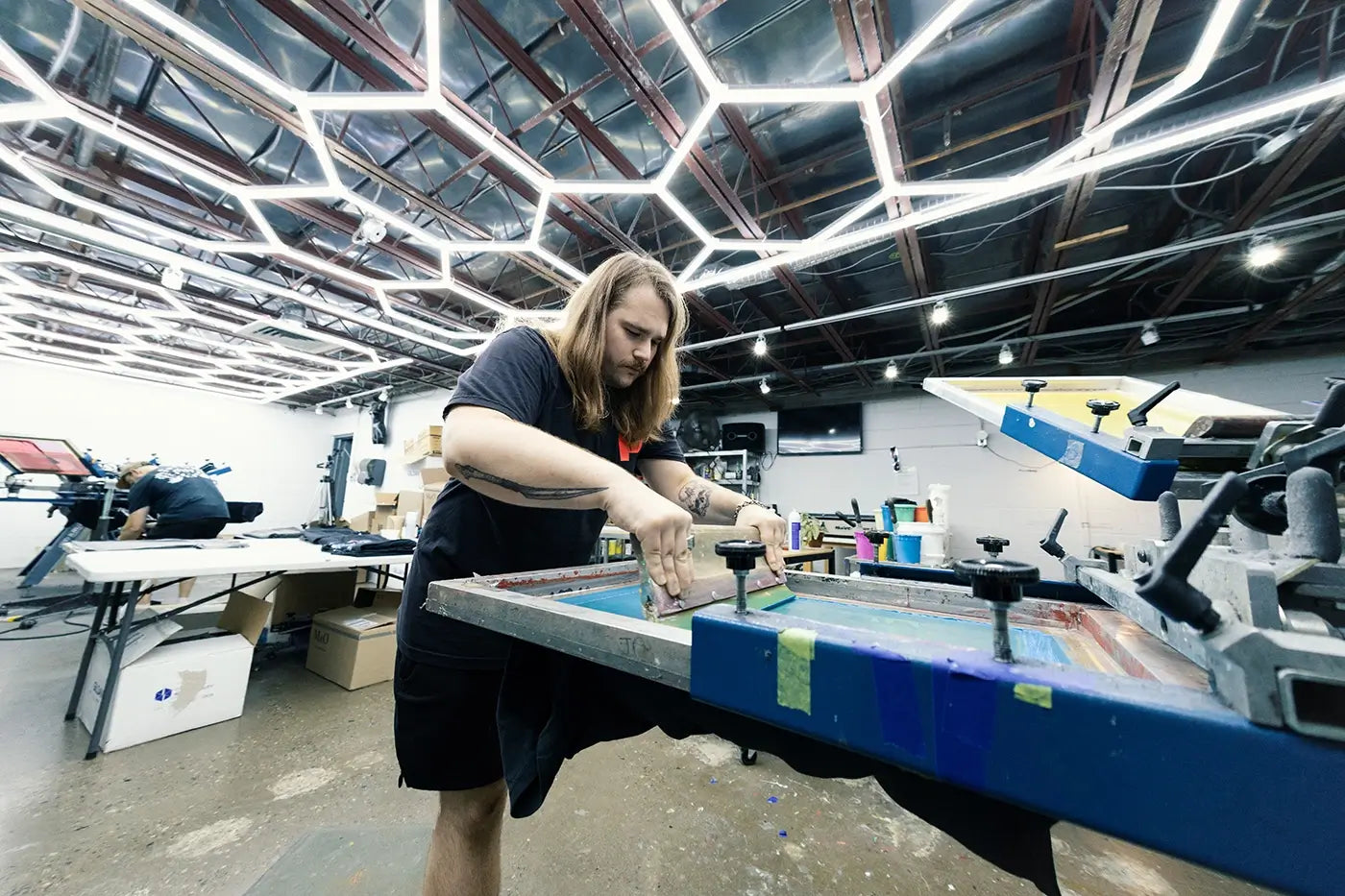Fast Turnaround Custom Screen Printing for Events
Wiki Article
Display Printing Uncovered: Whatever You Required to Know Regarding Tee and Garment Printing Methods
Screen printing is a remarkable approach that incorporates art with strategy, using countless opportunities for creative thinking. Prepared to check out the crucial components that make display publishing an art type?
The Essentials of Display Printing: Exactly How It Works
When you dive right into screen printing, you'll uncover it's both a scientific research and an art. At its core, screen printing includes creating a stencil, or display, that allows ink to pass via only in certain areas.Position the screen over the material, after that use a squeegee to push ink with the screen onto the garment. Each action is essential, and mastering them will certainly boost your screen printing abilities, changing straightforward garments right into special, expressive items.
Sorts Of Display Printing Techniques
Once you grasp the essentials of screen printing, it's time to explore the various techniques that can raise your designs. One preferred technique is typical screen printing, where ink is pressed through a stenciled screen.If you're intending for great details, think about discharge printing. This method eliminates color from the fabric, leaving a soft, classic look. Another alternative is plastisol printing, understood for its resilience and vivid shades, making it a favorite for numerous brand names. Experiment with halftone printing to create gradient results and intricate layouts. Each method has its unique appeal, so do not hesitate to try them out to find what suits your style best!
Vital Devices for Display Printing
To accomplish sensational results in display printing, having the best equipment is fundamental. You'll require a durable display printing frame, which holds the mesh that moves your design onto the garment. Next, spend in top quality squeegees; these are crucial for using ink evenly throughout the display.Selecting the Right Inks and Materials
When selecting inks and products for screen printing, you require to take into consideration the kind of ink that functions finest for your project. Assume regarding fabric compatibility to guarantee your layouts look terrific and last long. Explore eco-friendly ink choices to make your printing procedure much more lasting.Kinds of Screen Inks
Picking the best display ink is vital for achieving lively, long lasting prints that satisfy your task's requirements. There are several types of display inks to examine. Plastisol ink is popular for its versatility and convenience of usage, offering exceptional shade opacity on dark fabrics. Water-based ink, on the various other hand, uses a softer feeling and is eco-friendly, making it perfect for those wanting to minimize their environmental impact. Release inks get rid of dye from the fabric, resulting in a soft, vintage look however call for certain handling. Specialized inks, such as metallic or glow-in-the-dark, can add special results to your designs. Review your project needs and choose the ink that straightens ideal with your preferred result.
Fabric Compatibility Considerations
Understanding material compatibility is vital for accomplishing high-quality display prints, especially given that various materials react distinctively to numerous inks. Always test your inks on example material to guarantee they adhere appropriately and keep color stability. Additionally, keep in mind that material weight and texture can impact the final end result, so choosing the right ink and material combination is crucial for your job's success.Eco-Friendly Ink Options
Environmentally friendly inks are ending up being a prominent choice for screen printers who desire to lessen their ecological influence while preserving quality. When picking inks, consider water-based inks, which are less harmful and much easier to clean up contrasted to standard solvents.In addition, try to find inks made from renewable energies, such as soy or vegetable-based options. By selecting the ideal inks and materials, you'll not only create sensational designs but additionally add to an extra sustainable printing process. Make the button, and your prints will certainly show your commitment to the environment!
Preparing Your Design for Display Printing

Submit Format Requirements
To assure your design looks sharp and vibrant on material, you'll require to pay very close attention to file format needs for screen printing. Start with vector files like AI or EPS, as they can be scaled without shedding top quality. If you utilize raster pictures, go with high-resolution data, such as TIFF or PNG, preferably at 300 DPI. Prevent using JPEGs, as they can shed clearness when resized. Make certain your layout has a clear history to avoid silk screen printing undesirable white sides on your prints. Keep color settings in mind; CMYK is standard for screen printing, so convert your RGB develops appropriately - screen printing kit. By adhering to these guidelines, you'll establish your art work up for an effective print.Color Splitting Up Strategies
Color separation is a crucial action in preparing your design for display printing, and grasping it can substantially boost your print top quality. You'll need to break your style right into individual shades, as each shade needs a separate screen during printing. Start by recognizing all the colors in your design and create layers each. You can use software like Adobe Photoshop or Illustrator to isolate and separate colors efficiently. Be certain to conserve each layer as a separate data, usually in a format like TIFF or PSD. This accuracy not only ensures precise color depiction yet additionally enhances the printing process. By taking note of shade separation, you'll attain lively and specialist outcomes in your screen-printed garments.Resolution and Dimension
Accomplishing the most effective cause screen printing begins with guaranteeing your design has the right resolution and dimension. Ideally, your art work needs to be at least 300 DPI (dots per inch) for sharp, clear prints. Your last item may look unprofessional and pixelated. if you use lower resolution.When it pertains to dimension, think about the dimensions of your print location. Style your artwork to match the final print dimension, ideally developing it in the real measurements you'll be printing. By doing this, you'll avoid any unexpected scaling concerns.
Always examine your layout in both vector and raster styles. Vector graphics can be scaled without shedding quality, making them suitable for display printing. Preparing properly will assure your design looks amazing on every garment!
Step-by-Step Display Printing Refine
Screen printing is a vibrant process that permits you to produce vibrant layouts on numerous surfaces. To get going, you'll require a display, emulsion, and your chosen ink. Initially, prepare your display by cleaning it completely. Next, apply the solution equally and allow it dry in a dark area. When completely dry, subject your screen to light with your style placed on it, which will harden the emulsion where the light hits, producing a pattern - screen printing kit.Pour ink onto the screen and utilize a squeegee to press the ink through the pattern onto the material. Lift the display thoroughly and allow the print dry. You have actually successfully screen published your layout.
Tips for Effective Screen Printing Projects
While you're diving into your display printing tasks, bear in mind that preparation is vital to success. Beginning by gathering all your materials-- inks, screens, mops, and garments. A tidy workspace aids avoid unwanted errors, so neat up before you start.Following, validate your art work is high-resolution and properly sized for your garment. Evaluate your display for proper exposure and tidy it completely to prevent spots. When blending your inks, adhere to the manufacturer's standards to attain the ideal consistency.
During printing, apply even stress with your squeegee for consistent results. Do not rush; take your time to validate each print meets your criteria. After printing, allow your garments completely dry completely prior to handling or packaging them.
Finally, constantly maintain a sample of your benefit future referral. This way, you can assess your development and boost your techniques gradually. Satisfied printing!

Often Asked Concerns
How Long Does It Require To Set up a Screen Printing Work?
Establishing up a display printing task typically takes about half an hour to an hour. You'll prepare the displays, mix inks, and adjust journalism. The moment differs based on complexity and experience, so remain organized!Can I Print on Various Textile Types Utilizing the Exact Same Strategy?
Yes, you can publish on various fabric types using the exact same method, yet you'll require to change your inks and settings. Some fabrics take in ink differently, so experimenting assurances the most effective results for each and every material.What Are Typical Blunders to Stay Clear Of in Screen Printing?
When display printing, prevent typical mistakes like utilizing the incorrect ink, overlooking correct exposure times, or avoiding pre-press checks. Always examine your arrangement and keep tidy displays to assure top quality results each time.Just How Can I Appropriately Clean and Maintain My Screen Printing Equipment?
To appropriately clean and keep your display printing equipment, you need to routinely clean displays with suitable solvents, examine squeegees for wear, and guarantee all tools are kept dust-free and completely dry. Uniformity protects against pricey repair work and improves performance.Is Display Printing Ecologically Pleasant Compared to Various Other Methods?
Screen printing can be more eco-friendly than various other methods, specifically if you utilize water-based inks and eco-conscious materials. By selecting lasting materials and practices, you lower waste and lessen your influence on the earth.Screen Printing Uncovered: Every Little Thing You Need to Know Regarding Tee Shirt and Garment Printing Strategies
At its core, screen printing includes developing a pattern, or display, that allows ink to pass via just in certain areas. Position the display over the fabric, after that utilize a squeegee to press ink via the display onto the garment. One preferred method is typical display printing, where ink is pushed via a stenciled display.When choosing inks and materials for display printing, you require to take right into account the type of ink that works ideal for your project.
Report this wiki page